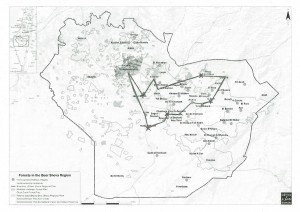 1. The undersigned returns from a hike (walkers and cyclists) organized by a Belgian association – Solidarity with Bedouins (SWB) – in the desert of Negev (Naqab in Arabic) in Israel from 1 to 6 April 2013 (map and pictures 1-4). This hike linked several Bedouin villages unrecognized by the Israeli administration, around the city of Be’er Sheva. (pictures 5-6). Having seen firsthand the situation of Bedouin in Israel (pictures 5-6), the undersigned wishes to respond to the emotion of the observations and meetings (pictures 7-9) by a cold and, he hopes, lucid analysis of public international law applicable to the question.
1. The undersigned returns from a hike (walkers and cyclists) organized by a Belgian association – Solidarity with Bedouins (SWB) – in the desert of Negev (Naqab in Arabic) in Israel from 1 to 6 April 2013 (map and pictures 1-4). This hike linked several Bedouin villages unrecognized by the Israeli administration, around the city of Be’er Sheva. (pictures 5-6). Having seen firsthand the situation of Bedouin in Israel (pictures 5-6), the undersigned wishes to respond to the emotion of the observations and meetings (pictures 7-9) by a cold and, he hopes, lucid analysis of public international law applicable to the question.
A. The facts
2. Prior to 1948, some 92,000 Arab Bedouin were living in the Negev/Naqab. The 1948 war between Israel and its neighbours led to the exodus of the majority of the Bedouin community to neighbouring countries. The 11,000 Bedouins who were left behind were gathered in the northern Negev / Naqab by the military government of Israel in an area called « Siyag » (fence in Arabic) (The Arab Bedouin and the Prawer Plan, Adalah (Legal Center for Arab Minority Rights in Israel), n.d., www.adalah.org). The Israeli authorities would have told them that they could return to their ancestral lands within 6 months (Ibid., p. 1 ; STEINERT, I., in www.ujfp.org/IMG/doc/Steinert-1.doc, consulted on 13 October 2013, p. 8). It did not happen:
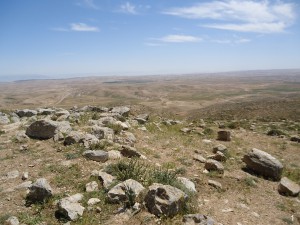 Bedouins gathered in the Siyag could not return to their land;
Bedouins gathered in the Siyag could not return to their land;- they obtained no ownership rights on the lands in the Siyag where they had been displaced;
- property rights of Bedouins who were already living in the Siyag before the creation of Israel were not recognized (The Arab Bedouin and the Prawer Plan, op. cit., p. 1).
3. Bedouins who fled Israel and who returned were then installed in 1969 in seven urban communities created by Israel and which today account for 85% of the native Bedouin population of the Negev / Naqab 105 000 people. Bedouin communities who had not been displaced and who remained on their historical lands (95,000 people) live in 35 unrecognized villages that existed before the creation of Israel and in 10 villages in the process of recognition. The population of these villages varies from 300 to 10 000 people (ibid.).
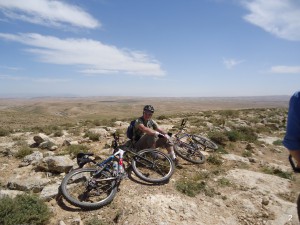 As Israel does not recognize these 35 villages as urban communities, Israel refuses to provide them with the basic public services provided to any Israeli urban concentration: running water, electricity, roads, schools; in addition, the Bedouins who live in these villages and who, legally, are Israeli citizens are treated as intruders or squatters illegally installed on Hebrew State lands. They live under constant threat of being forcibly evicted and having their dwellings demolished; in 2011, 1,000 Bedouin houses in these villages in the Negev / Naqab had been demolished by bulldozers (ibid.).
As Israel does not recognize these 35 villages as urban communities, Israel refuses to provide them with the basic public services provided to any Israeli urban concentration: running water, electricity, roads, schools; in addition, the Bedouins who live in these villages and who, legally, are Israeli citizens are treated as intruders or squatters illegally installed on Hebrew State lands. They live under constant threat of being forcibly evicted and having their dwellings demolished; in 2011, 1,000 Bedouin houses in these villages in the Negev / Naqab had been demolished by bulldozers (ibid.).
4. Participants in the hike organized by SWB having seen the sad spectacle of demolished houses, the question that immediately comes to the mind of the viewer is whether this situation is consistent with the law. This will be answered in the light of public international law.
B. The law
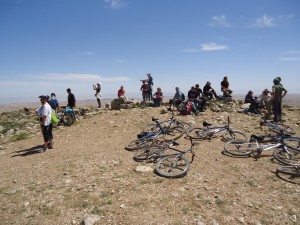 5. The Bedouin claim a right of ownership over their land. The legal basis of this right in general international law is Art. 17 of the Universal Declaration of Human Rights (UDHR), which states:
5. The Bedouin claim a right of ownership over their land. The legal basis of this right in general international law is Art. 17 of the Universal Declaration of Human Rights (UDHR), which states:
“(1) Everyone has the right to own property alone as well as in association with others.
(2) No one shall be arbitrarily deprived of his property.”
The prohibition opposed by Israel to the Bedouins to resettle in their ancestral lands and to recognize their individual rights to these lands is a denial of these rights, thus a violation of their property rights. In 1972, the Israeli courts seized by Bedouins had rejected land claims because the title of the Bedouins had never been recorded before 1948 and because the land had not been cultivated, which, according to Ottoman law, would have allowed them to consider it not as « dead land » (STEINERT, loc. cit., p. 5 ; also http://apjp.org/israel-court-rejects-6-bedouin/author/archplanjust consulted on 13 October 2013), but as land held by persons in their private capacity.
6. These arguments were repeated in 2010, when a lawsuit brought against Israel by 17 Bedouin of the al-Uqbi family who claimed 820 dunams of land (+/- 8.2 ha or 20,5 acres); on March 25, 2012, the Beer Sheva District Court – Judge Sarah Dovrat – dismissed the plaintiffs for reasons substantially similar to those set out in 1972:
- The alleged titles had not been registered in the Tabu, the Ottoman land registry;
- The British, who followed the Ottomans when they received the mandate over Palestine, would have required that the land owned privately was recorded in 1921 at the latest, what neither the al-Uqbi family nor most Bedouin did ;
- to the argument that the Bedouins enjoyed legal autonomy to resolve land issues and that the Bedouin law did not require such registration, the court said that if the Ottomans had wanted to exempt a population of the application of the law, they would have said so explicitly (ibid.).
7. These decisions are dismaying as they apply to the Bedouin society exogenous rules specific to a quite different social system. From a legal point of view, it is the law of the Bedouin society that should have been considered, not an imported law unrelated to the Bedouin social reality. A basic rule of transitional or intertemporal law requires that a behaviour be assessed according to the law in force at the time of the behaviour. In 1975, the Institute of International Law in the resolution adopted in Wiesbaden, said:
“Unless otherwise indicated, the temporal sphere of application of any norm of public international law shall be determined in accordance with the general principle of law by which any fact, action or situation must be assessed in the light of the rules of law that are contemporaneous with it. […]” (For other examples drawn from practice, see SALMON, J. and DAVID, E., Droit international public, Pr. univ. Bxl., 25th ed. 2013, § 4.6.19)
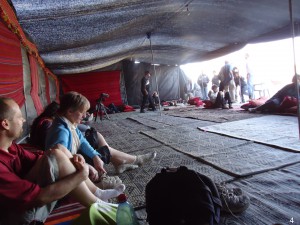 In casu, you must not be a licensed specialist in Bedouin legal anthropology to understand that the concept of land registry should be so foreign to the Bedouins that they had never thought it useful to incorporate into their customs and traditions a rule specific to societies where the territorial divisions of the space were to be as accurate as possible, and thus required some form of registration rules. As an author has written about usages in the Arab village:
In casu, you must not be a licensed specialist in Bedouin legal anthropology to understand that the concept of land registry should be so foreign to the Bedouins that they had never thought it useful to incorporate into their customs and traditions a rule specific to societies where the territorial divisions of the space were to be as accurate as possible, and thus required some form of registration rules. As an author has written about usages in the Arab village:
“As long as the neighbours do not argue, the boundaries are rather vague: a pond, a tree, a hill … mark the border in an indicative way.” (translation from French) (In Systèmes fonciers à la ville et au village, Paris, L’Harmattan, 1986, p. 272)
Bedouin system has always been very far from a practice of pillar and cadastre such as Israeli justice envisaged. It is also likely that, for domestic peace, the administration of territorial spaces in the Ottoman Empire, which stretched over three continents (Europe, Asia, Africa) before its dissolution in 1923, had integrated local customs and traditions in land matters. It was therefore quite logical on the one hand, that the Palestinian Bedouins did not comply with the land registration rules in force in the Ottoman Empire, on the other hand, that the latter never imposed them.
It is therefore in the light of the law specific to Bedouin society that land issues must be considered, and that is precisely what states international law about indigenous peoples.
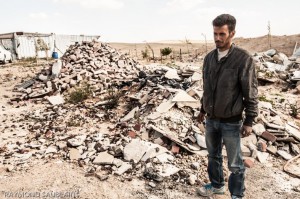 8. Membership of the Bedouins to the category of indigenous peoples derives from the definition carried by 1989 ILO Convention No. 169 concerning Indigenous and Tribal Peoples Convention, i.e.
8. Membership of the Bedouins to the category of indigenous peoples derives from the definition carried by 1989 ILO Convention No. 169 concerning Indigenous and Tribal Peoples Convention, i.e.
“peoples in independent countries who are regarded as indigenous on account of their descent from the populations which inhabited the country, or a geographical region to which the country belongs, at the time of conquest or colonisation or the establishment of present state boundaries and who, irrespective of their legal status, retain some or all of their own social, economic, cultural and political institutions.” (Art. 1, § 1, b)
Israel is not a party to that Convention which, in 2013, bound only 22 States, but the definition of native or indigenous people carried by the agreement corresponds exactly to the reality of the Bedouin people.
9. Now, the UNGA adopted on 13 September 2007, a Declaration on the Rights of Indigenous Peoples (A/RES/61/295) by 143 votes against 4 – Australia, Canada, United States and New Zealand – with 11 abstentions – Colombia, Azerbaijan, Bangladesh, Georgia, Burundi, Russia, Samoa, Nigeria, Ukraine, Bhutan and Kenya; unsurprisingly, Israel was absent for the vote. This Declaration provides, inter alia, in Art. 10, 26-28:
“Art. 10. Indigenous peoples shall not be forcibly removed from their lands or territories. No relocation shall take place without the free, prior and informed consent of the indigenous peoples concerned and after agreement on just and fair compensation and, where possible, with the option of return.
[…]
Art. 26. 1. Indigenous peoples have the right to the lands, territories and resources which they have traditionally owned, occupied or otherwise used or acquired.
2. Indigenous peoples have the right to own, use, develop and control the lands, territories and resources that they possess by reason of traditional ownership or other traditional occupation or use, as well as those which they have otherwise acquired.
3. States shall give legal recognition and protection to these lands, territories and resources. Such recognition shall be conducted with due respect to the customs, traditions and land tenure systems of the indigenous peoples concerned.
Art. 27. States shall establish and implement, in conjunction with indigenous peoples concerned, a fair, independent, impartial, open and transparent process, giving due recognition to indigenous peoples’ laws, traditions, customs and land tenure systems, to recognize and adjudicate the rights of indigenous peoples pertaining to their lands, territories and resources, including those which were traditionally owned or otherwise occupied or used. Indigenous peoples shall have the right to participate in this process.
Art. 28. 1. Indigenous peoples have the right to redress, by means that can include restitution or, when this is not possible, just, fair and equitable compensation, for the lands, territories and resources which they have traditionally owned or otherwise occupied or used, and which have been confiscated, taken, occupied, used or damaged without their free, prior and informed consent.
2. Unless otherwise freely agreed upon by the peoples concerned, compensation shall take the form of lands, territories and resources equal in quality, size and legal status or of monetary compensation or other appropriate redress.”
These provisions set out four basic rules:
- The prohibition to deprive indigenous peoples of their lands or territories (Art. 10);
- The right of indigenous peoples to own and use these lands or territories (Art. 26);
- The right of indigenous peoples to respect for their land tenure systems (Art. 26 § 3;. Art. 27);
- The right of indigenous peoples to obtain reparation (restitution or compensation) for any deprivation of their lands or territories (art. 10 and 28).
The ownership of land and territories to indigenous peoples is determined by their traditional occupation or possession, a qualification that appears not less than four times in the three relevant provisions of the Declaration (Art. 26, § § 1-2; Art. 27 and Art. 28, § 1). It is therefore no question of determination of the membership on the basis of criteria imposed a posteriori by the dominant group (the Israeli authorities) such as the registration in official documents whose conception remains completely foreign to traditional customs of the indigenous people. By ignoring these rules, the Israeli judicial decisions are, therefore, groundless.
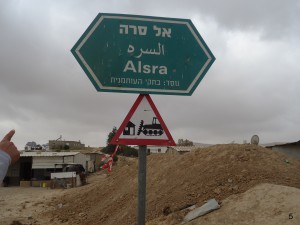 10. Besides the fact that the Israeli judicial decisions are unfounded, Israel is preparing to implement a plan to finally settle the Bedouin issue: the Begin-Prawer plan (Text in http://fr.scribd.com/doc/154461816/The-full-translated-text-of-Israel-s-Prawer-Plan) adopted on June 24, 2013 by the Knesset (43 votes, 40 against) (http://www.pourlapalestine.be/index.php?option=com_content&view=article&id=1574:la-knesset-approuve-le-tres-accablant-plan-prawer-begin&catid=1:latest-news) provides for the deportation and forced displacement from 30 000 to 40 000 Bedouin of the unrecognized villages (http://www.eccpalestine.org/discriminatory-prawer-plan-to-evict-tens-of-thousands-of-bedouins-from-their-communities-in-the-negev/). This project has been criticized by the Committee on the Elimination of Racial Discrimination, established by the UN Convention of 7 March 1966 on the Elimination of All Forms of Racial Discrimination, which binds Israel since January 3, 1979. In its annual report released on April 3, 2012 (Doc. ONU CERD/C/ISR/CO/14-16, 10 p.), the Committee writes:
10. Besides the fact that the Israeli judicial decisions are unfounded, Israel is preparing to implement a plan to finally settle the Bedouin issue: the Begin-Prawer plan (Text in http://fr.scribd.com/doc/154461816/The-full-translated-text-of-Israel-s-Prawer-Plan) adopted on June 24, 2013 by the Knesset (43 votes, 40 against) (http://www.pourlapalestine.be/index.php?option=com_content&view=article&id=1574:la-knesset-approuve-le-tres-accablant-plan-prawer-begin&catid=1:latest-news) provides for the deportation and forced displacement from 30 000 to 40 000 Bedouin of the unrecognized villages (http://www.eccpalestine.org/discriminatory-prawer-plan-to-evict-tens-of-thousands-of-bedouins-from-their-communities-in-the-negev/). This project has been criticized by the Committee on the Elimination of Racial Discrimination, established by the UN Convention of 7 March 1966 on the Elimination of All Forms of Racial Discrimination, which binds Israel since January 3, 1979. In its annual report released on April 3, 2012 (Doc. ONU CERD/C/ISR/CO/14-16, 10 p.), the Committee writes:
“20. The Committee is concerned about the current situation of Bedouin communities, particularly with regard to the policy of demolitions, notably of homes and other structures, and the increasing difficulties faced by members of these communities in gaining access on a basis of equality with Jewish inhabitants to land, housing, education, employment and public health.
The Committee recommends that the State party address satisfactorily the problems faced by Bedouin communities, in particular with regard to the loss of their land and access to new land. The Committee also recommends that the State party step up its efforts to ensure equal access to education, work, housing and public health in all territories under the State party’s effective control. In this regard, the State party should withdraw the 2012 discriminatory proposed Law for the Regulation of the Bedouin Settlement in the Negev, which would legalize the ongoing policy of home demolitions and forced displacement of the indigenous Bedouin communities.
[…]
25. The Committee is increasingly concerned at the State party’s discriminatory planning policy, whereby construction permits are rarely if ever granted to Palestinian and Bedouin communities and demolitions principally target property owned by Palestinians and Bedouins. The Committee is concerned at the adverse tendency of preferential treatment for the expansion of Israeli settlements, through the use of “state land” allocated for settlements, the provision of infrastructure such as roads and water systems, high approval rates for planning permits and the establishment of Special Planning Committees consisting of settlers for consultative decision-making processes. The Committee is greatly concerned at the State party’s policy of “demographic balance”, which has been a stated aim of official municipal planning documents, particularly in the city of Jerusalem (Articles 2, 3 and 5 of the Convention).
In light of its previous concluding observations (CERD/C/ISR/CO/13, para. 35) and considering that the current Israeli planning and zoning policy in the West Bank, including East Jerusalem, seriously breaches a range of fundamental rights under the Convention, the Committee urges the State party to reconsider the entire policy in order to guarantee Palestinian and Bedouin rights to property, access to land, access to housing and access to natural resources (especially water resources). The Committee also recommends that any planning and zoning policy be implemented in consultation with the populations directly affected by those measures. It calls on the State party to eliminate any policy of ‘demographic balance’ from its Jerusalem Master Plan as well as from its planning and zoning policy in the rest of the West Bank.” (Ibid., pp. 5 and 7)
The report of the Committee observes in diplomatic terms that the Prawer-Begin plan violates the UN Convention of 7 March 1966 on the Elimination of All Forms of Racial Discrimination, which binds Israel since January 3, 1979.
*
 11. In summary, it is clear that the Israeli policy towards the Bedouin communities in the Negev / Naqab violates
11. In summary, it is clear that the Israeli policy towards the Bedouin communities in the Negev / Naqab violates
- the 1948 UDHR and the traditional property rights of the Bedouins (Art. 17);
- the UN Convention of 7 March 1966 on the Elimination of All Forms of Racial Discrimination (Art. 2, 3, 5);
- the Declaration of the UN General Assembly of 13 December 2007 on the rights of indigenous peoples, in particular the Bedouins’ right for respect of their traditional land rights and occupation of their lands and territories (Art. 10, 26-28 ).
12. Israel’s policy towards the Bedouin is not only a violation of international law: it also constitutes a criminal offence as an apartheid crime a crime against humanity.
13. Regarding the crime of apartheid, the UN Convention of 30 November 1973 criminalizes
“(c) Any legislative measures and other measures calculated to […] the deliberate creation of conditions preventing the full development of such a group or groups, in particular by denying to members of a racial group […] basic human rights and freedoms, including […] the right to freedom of movement and residence […]
d) Any measures including legislative measures, designed to divide the population along racial lines by the creation of separate reserves and ghettos for the members of a racial group or groups, […] the expropriation of landed property belonging to a racial group or groups or to members thereof;
[…]” (Art. II).
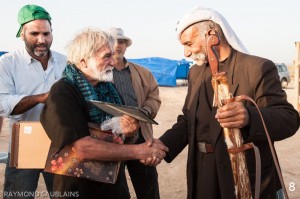 The notion of racial group is not defined in the Convention, but it refers to discriminatory practices under the 1966 Convention, which provides that
The notion of racial group is not defined in the Convention, but it refers to discriminatory practices under the 1966 Convention, which provides that
“the term ‘racial discrimination’ shall mean any distinction, exclusion, restriction or preference based on race, colour, descent, or national or ethnic origin which has the purpose or effect of nullifying or impairing the recognition, enjoyment or exercise, on an equal footing, of human rights and fundamental freedoms […]” (Art. 1, § 1) (emphasis added)
The text shows that racial discrimination is defined sociologically (discrimination based on « descent or national or ethnic origin ») not biologically and can be applied to the Bedouins; that is exactly what the Committee on the Elimination of racial discrimination said (supra § 10). Now insofar as the Israeli policy (namely the Prawer-Begin plan)
- prevents the Bedouins to choose their residence on their ancestral lands,
- leads Israel to seize the Bedouin land, and
- creates places for Bedouins,
this policy corresponds to the facts defined as apartheid by Art. II of the 1973 Convention the relevant passages of which are reproduced above (In 2011, at its third session on Palestine, Russell Tribunal had made the same observation about the Israeli practices against the Palestinian people, http://www.russelltribunalonpalestine.com/en/wp-content/uploads/2011/09/RToP-Cape-Town-full-findings2.pdf).
14. Such facts constitute « crimes against humanity” since the 1973 Convention on the crime of apartheid (art. 1) that the ICC Statute (art. 7, § 1, j) call apartheid crime against humanity.
15. Finally, one may wonder whether the treatment of Bedouins by Israel does not amount to a form of sociocide, namely, the destruction of what constitutes a social group characterized by language, culture and lifestyle unique to this group and claimed by this group since this destruction is the intentional fact of a State or of another group. In the case of the Negev Bedouins, their attachment to parts of the Negev, where they have lived for centuries and where they graze goats and camels is a specific element of the group, element whose removal could support the conclusion that this removal leads to sociocide even if sociocide not yet a concept of positive law; the final findings of the Russel Tribunal, during the Brussels session (16-17 March 2013) are eloquent:
“An example of destruction of an ethnic and social way of life which amounts to sociocide is particularly clear in the case of the Palestinian Bedouins living in the Israeli Negev (Naqab in Arabic). Since the 16th century, it has been the custom of the Naqab Bedouins to move around their usual settlements with their herds of goats and camels which changed grazing according to seasons. During the 1948 war between Israel and its Arab neighbours, Israel compelled the Bedouins to leave these traditional settlements and to stay in a small area of the northern Naqab. Israel promised that they would be allowed to come back to their ancestral lands six months later. The promise was not fulfilled and today half of the Naqab Bedouins live in 46 ‘unrecognized’ villages, only 10 of which are in ‘the process of recognition’ by Israel.” (http://www.russelltribunalonpalestine.com/en/full-findings-of-the-final-session-fr ; for the printed version of the final findings, see Russell Tribunal on Palestine, 2007-2013, pp. 20-21; 51 (French text, p. 51 ; Spanish text, p. 83).
* *
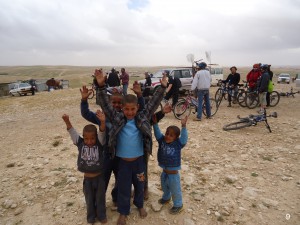 16. The conclusion is quite simple: the emotion and feeling of revulsion felt by the spectator before the Bedouin houses destroyed by Israeli bulldozers finds a form of (symbolic) consolation in finding that public international law formally condemns the destruction as well as the fate reserved by Israel to the Bedouin community in the Negev / Naqab. So far, this does not change the fate of this community, but it is not impossible that one day, the facts eventually comply with the strength of the norms. History will judge Israel without complacency; in the meantime, one must continue the struggle so that the rule of law becomes a reality.
16. The conclusion is quite simple: the emotion and feeling of revulsion felt by the spectator before the Bedouin houses destroyed by Israeli bulldozers finds a form of (symbolic) consolation in finding that public international law formally condemns the destruction as well as the fate reserved by Israel to the Bedouin community in the Negev / Naqab. So far, this does not change the fate of this community, but it is not impossible that one day, the facts eventually comply with the strength of the norms. History will judge Israel without complacency; in the meantime, one must continue the struggle so that the rule of law becomes a reality.
* * *
This writer would like to take this opportunity to express his gratitude and thanks to SWB (and his leader, Marco Abramowicz, picture 8) for having organised this hike, to the Bedouins for their warm welcome to the hikers, to Arnaud Louwette, Assistant at the Centre for International Law, for having set this text on the Centre’s website, and to Google (!) for its partial assistance to the translation in English of this text …
